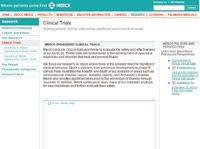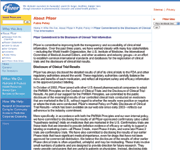Clear Road Ahead
Increased availability of clinical-trials information allows patients to identify trials in which they may participate, assess safety issues, and easily register.
There is little doubt that the issue of clinical-trial registries will remain front and center in 2005.
Spurred on by concerns over drug safety, healthcare professionals and patients alike have demanded access to all information regarding trials and their results. In response, over the past few months, government agencies, industry associations, and pharma companies have launched clinical-trial registries and results databases.
The objective is to make information about clinical trials—both initiation and results—available to healthcare professionals and the public in an unbiased, scientific, and timely manner. Information is not limited to interpretations of a trial's results or conclusions that can be drawn from a study. The results—positive or negative—are published in full. In principle, this increased transparency should enhance patient care by giving physicians objective, comprehensive data on all products, including those under development.

AstraZeneca astrazenecaclinicaltrials.com
From the perspective of pharma companies, a trial registry can be used by investigators to facilitate patient enrollment in clinical trials. The increased availability of information allows patients to identify trials in which they may participate, assess safety and efficacy issues, and easily register to participate.
Registries also offer implied benefits, such as a potential reduction in the negative news coverage that currently undermines consumers' faith in the clinical-trial process. Patients can use the information contained in the registry to track a particular clinical study and identify issues for discussion with their physicians. Registries can offer significant benefits to consumers, healthcare professionals, and the industry, but they must be set up effectively to realize these benefits. It is crucial for pharma companies today to be aware of the rapid evolution of registries, and the strategies they employ to balance patient welfare and the needs of companies performing drug development.

GSK ctr.gsk.co.uk
The Evolution of Registries
Today's registry movement began in Section 113 of the FDA Modernization Act (FDAMA) of 1997. Section 113 established the Clinical Trials Data Bank (CTDB), which since February 2000, has made information available to the public through the National Library of Medicine's site, www.clinicaltrials.gov. Registration within 21 days of inception is mandatory for all clinical studies involving serious or life-threatening diseases or conditions. Specifically, Section 113 requires that CTDB contain the following:
1. Information about both federally and privately funded clinical trials of experimental treatments (including both drug and biological products) for patients with serious or life-threatening diseases and conditions
2. Description of the purpose of each experimental treatment
3. Patient-eligibility criteria
4. Location of clinical-trial sites
5. Contact information for patients wishing to enroll.
Clinicaltrials.gov was designed to make consumers more aware of trials they could participate in. Posting of results was voluntary. But in many ways the real impact of Section 113 has come more recently, as other groups—such as the American Medical Association (AMA), the International Committee of Medical Journal Editors (ICMJE), and the International Federation of Pharmaceutical Manufacturers and Associa-tions (IFPMA)—have adopted it as a platform upon which to build their own approaches.

Eli Lilly www.lillytrials.com
The PhRMA principles In 2002, PhRMA issued its "Principles on the Conduct of Clinical Trials and Communication of Clinical Trial Results," in which member companies committed to registering "all company-sponsored hypothesis-testing (non-exploratory) clinical trials conducted on drugs and biologics marketed in the US or intended for marketing in the US, regardless of disease studied or the location of the trial." Hypothesis testing may occur at any stage of drug development and includes all Phase III studies, some earlier-phase studies, and many studies of marketed products. Because of the proprietary nature of exploratory studies, PhRMA specifically excluded them, unless the results were of medical significance.

Rochewww.roche-trials.com
In October 2004, PhRMA formally launched its own clinical-trial database at www.clinicalstudyresults.org, a centralized, voluntary repository for study results for products marketed in the United States. PhRMA urged all companies to post unpublished results within 12 months of completion of a trial. According to the organization, information on 136 drugs is available on the site. In January, PhRMA issued a new clinical-trial registry proposal: By July 1 pharma companies were to voluntarily post details on all newly initiated hypothesis-testing clinical trials at study initiation, either on their corporate Web sites, at www.clinicaltrials.gov, or at www.clinicalstudyresults.org. Ongoing hypothesis-testing trials were to be posted by September 13, 2005. To meet minimum standards, these postings must include:
- study description in easily understood terminology
- study purpose, type, and phase
- study status
- type of intervention
- illness or condition studied
- inclusion/exclusion criteria
- site location and/or contact information.
Beyond these minimum requirements, the proposal called for companies to:
- provide information on studies conducted outside of the United States
- develop standards for verifying adherence to these guidelines
•use a unique identifier for trials to permit easy cross-reference (trials listed on Clinicaltrials.gov are already given a unique identifier)
- place protocols with a secure third party for later disclosure.
American Medical Association The AMA also became involved in the registries issue in late 2004. In September 2004, AMA trustee Ronald M. Davis, MD, speaking before the House Committee on Energy and Commerce, Subcommittee on Oversight and Investigations, outlined five key elements needed to make a clinical-trials registry effective:
1. The system should include all trials, Phase II through IV, of drugs, biologics, and devices.
2. Identifying information, including study sponsor, unique identifier, funding entity, and contact information for responsible individuals, should be provided.
3. Name, purpose, and design of the study; the diseases and population being studied; key study dates, location; and patient-recruitment status should be supplied in an easy-to-understand format.
4. Results should be provided in a central repository, with links to sites containing additional published reports.
5. Participation should be considered a condition for approval by institutional review boards (IRBs).
ICMJE Considering that clinical-trials registration is mandated by federal law and supported by a final-guidance document, a targeted education program, and an easy-to-use Web-based data-entry tool, compliance has been mixed. While some companies voluntarily provide information that far exceeds the criteria specified by the guidance, others provide only limited information or, in some cases, none at all.

Genentech www.gene.com/gene/about/views/trial-transparency.jsp
Participation in Clinicaltrials.gov is voluntary, at least in the case of diseases that are not serious or life-threatening, and there is no congressional mandate to provide trial results. At the moment, perhaps the strongest incentive for registration is the policy, adopted by members of the International Committee of Medical Journal Editors in September 2004, stating that member publications would no longer consider studies for publication unless the trials were registered at a publicly accessible site run by a not-for-profit. At a minimum, Phase II to IV clinical trials must register the following information:
- unique trial number
- trial-registration date
- secondary IDs
- funding source(s)
- primary sponsor
- secondary sponsor
- responsible contact person
- research contact person
- title of the study
- official scientific title of the study
- research ethics review
- condition
- intervention(s)
- key inclusion/exclusion criteria
- study type
- anticipated trial start date
- target sample size
- recruitment status
- primary outcome
- key secondary outcomes
In order to comply with the ICMJE guidelines, trials starting after July 1, 2005 must be registered prior to or at the beginning of patient enrollment. For trials that are currently underway or that started prior to July 1, 2005, registration was required by September 13, 2005. These dates are consistent with the industry position issued by PhRMA in January.

Merckwww.merck.com/mrl/clinical_trials/
Pharma Company Practices
In addition to government and industry-wide policies, many companies have unveiled more detailed plans to increase the amount of clinical-trial information that is publicly available. With the possibility of regulatory mandates looming, certain industry players are attempting to set acceptable standards. Eli Lilly, GlaxoSmithKline, AstraZeneca, Roche, and others have already begun to post clinical-trial results on their corporate Web sites, generally following the basic formula laid out in the International Conference on Harmonization (ICH3) guidelines. Merck, Pfizer, Genentech, and others have committed to posting information on all hypothesis-testing Phase III and IV trials directly on www.clinicaltrials.gov, rather than on their corporate Web sites.
Eli Lilly has been a front runner in making both information about initiated clinical studies and study results publicly available. The company officially launched its corporate registry site (www.lillytrials.com) in December 2004, and a link to this site is prominently featured on its corporate home page. Lilly boasts a registry with results from more than ten years of clinical trials.

Pfizerwww.pfizer.com/pfizer/are/about_public/mn_about_clinical_trial.jsp
Lilly has specifically voiced the need for a uniform global standard for posting clinical-trial information to all stakeholders, including academia, industry, WHO, PhRMA, journal editors, and policymakers. From the company's perspective, the alignment of registry requirements in a single database that is accessible through one Web site would be ideal. While the company recognizes that there is a movement toward such a standard, Lilly also sees hurdles on the horizon, such as the lack of a compliance mechanism. Although the disclosure of clinical-trial results is not federally mandated, Lilly has made this disclosure a corporate standard and the company has even committed to utilizing a third party to audit and verify adherence to its standards of disclosure.
In terms of study initiation, all Phase II, III, and IV trials will be posted on Lilly's corporate registry and on an independent public registry site, such as www.clinicaltrials.gov, at the start of each study. At a minimum, the company makes the following information publicly available when a trial begins:
- unique trial-identification number
- brief title of the trial
- trial description in layman's terminology
- trial phase, type (e.g., interventional), status, and purpose (e.g., treatment, diagnosis, prevention)
- intervention type (e.g., drug, vaccine)
- condition or disease
- key eligibility criteria, including gender and age
- trial start date and projected end date
- location of the trial
- contact information.
Once a trial is completed, Lilly discloses Phase I, II, III, and IV results—regardless of outcome—no later than approval of the drug's first indication and commercial launch. Following the initial approval, results of all other Phase II, III, and IV clinical trials are disclosed within one year of trial completion. The only exception to these disclosure guidelines is when posting to the registry would compromise publication in a peer-reviewed medical journal. For studies that are being considered by peer-reviewed journals that prohibit pre-publication results disclosure, the results will be posted on the registry at the time of publication.
In addition to posting results, Lilly discloses a comprehensive description of the trial design and methodology for each study. The company also goes beyond the publication of raw data to include a summary of results, statistical analyses, safety data, and any peer-reviewed manuscripts that have been published.
GlaxoSmithKline has also been aggressive in making clinical-trial information available through its corporate Web site (ctr.gsk.co.uk). A link to GSK's registry is easily found on the corporate home page, and the registry includes information about clinical trials completed since the formation of GSK on December 27, 2000. With respect to currently marketed products, GSK is providing summaries of studies completed before that date, if the results are likely to inform medical judgment.
GSK intends to post summaries of pre-marketing trials of new medicines and new formulations of marketed medicines no later than the first launch of the product in a major market. For already-marketed GSK products, the company intends to post summaries of trials as they are completed, analyzed, and written up. It will include pre-marketing trials of new formulations before launch in a major market when these trials provide important safety information that is relevant to marketed formulations.
As with other registries, GSK's provides scientific, non-promotional summaries of clinical-trial results, regardless of whether the results may be viewed as positive or negative. GSK's clinical-trial summaries typically include the following characteristics:
- study title, rationale, objectives, and phase
- study design, treatment schedule, and location
- statistical methods
- study period
- study population and demographics
- results for primary and secondary endpoints defined in the trial protocol
- adverse events
- references to publications in medical literature, when publications of individual studies exist; when it has not been possible to publish a clinical trial within one year of posting on the registry, a conclusion is added to the trial summary.
AstraZeneca has a separate Web site dedicated to publishing its results (www.astrazenecaclinicaltrials.com). On July 1, 2005, the company began registering all of its new clinical trials that satisfy IFPMA's definition of hypothesis-testing. On September 13, 2005, the company began posting the results of all hypothesis-testing clinical trials it sponsors. Basic information on such trials will be posted on its corporate Web site, as well as on Clinicaltrials.gov. AstraZeneca has also committed to posting information on any new trial within 21 days of its inception.
Overall, AstraZeneca's registry is extremely comprehensive. The site includes postings of all core safety and efficacy registration trials for medicines approved since the formation of the company on April 6, 1999. It also includes global trials completed since that date, and US trials completed since January 1, 2005 for all currently approved medicines. The company points out that posting results is currently an ongoing process due to the large number of trials, but it plans to have its registry fully up-to-date by the end of 2005.
Genentech, in contrast, does not currently have a corporate site dedicated to registering clinical results, but the company has offered to provide more transparency to its research in accordance with the proposed ICMJE requirements. Protocol information is currently posted at Clinicaltrials.gov. Clinical-trial results of Phase II, III, and IV trials for marketed products approved after January 2003 are also to be posted.
In an effort to aid physicians and others in locating the information they need, Genentech has also been proactive in developing two guides: "Browsing Genentech Studies That Are Open for Enrollment" and "Accessing Genentech's Clinical Trial Study Results." Both can be found under the "Pipeline" tab at Genentech's Web site, www.gene.com.
The Registry Debate
With various companies applying somewhat different approaches to publicizing trial results, the biggest challenge has been—and will continue to be—putting standard operating procedures in place. These are necessary to ensure the quality of information and timelines for posting study results and the registration of clinical trials. PhRMA is currently in ongoing discussions with WHO to agree upon the data elements, timing, and protection of certain proprietary information for the registration of clinical trials. A critical challenge here is ensuring that there is a single global standard for these activities. In order to attain this goal, there may be some minor changes to the guidelines.
Several legitimate concerns are being raised by pharma companies regarding some of the proposed clinical-trial registry requirements and expansions.
Interpretation The idea behind trial registries is to allow public and healthcare professionals to draw their own conclusions by publishing data without synopses or interpretations. Many pharmaceutical companies argue that while they are very clearly and prominently posting information on their registry Web sites, the information being provided should not replace the informed medical advice or medical treatments of a healthcare professional. While registries and results databases may reduce bias in reported results, publication of uninterpreted scientific data opens a large window for misinterpretation. How will the public interpret results from similar trials with different outcomes? Without conclusions, how will consumers determine clinically and statistically significant results? How will the average person even understand the data?
Confidentiality One of the key purposes of clinical trials is to evaluate potential products for their effectiveness in treating specific disease states, in hopes of gaining regulatory approval. Maintaining confidentiality of this proprietary information at early stages is critical. Pharma companies' revenues depend on beating competitors to market with new or improved products. If companies are forced to share proprietary information early in the clinical-trial process, they could lose significant competitive advantage. Substantial loss of the financial benefits of innovation could, in turn, deter pharma companies from investing as heavily in drug development.
Pharma has offered several suggestions for effectively maintaining corporate confidentiality without cost to consumer interests. The majority of these suggestions involve limiting the information published at trial initiation regarding clinical-trial design. This would mean delaying the posting of certain pieces of information until the company can reasonably file for intellectual-property protection or publish an article in a referred journal.
In this scenario, the company's need to protect proprietary information could easily be balanced with the public's desire for disclosure. Companies could be required to publicly register an outline or overview to be updated as the trial progresses. In coordination with this effort, the complete protocol could be filed with a disinterested third party. This third party would maintain confidentiality until the study is completed or terminated. Because the clinical-trial endpoints are defined up front in the protocol, companies could not selectively disclose trial results. Therefore, the public gets access to the desired information while the companies maintain the necessary level of confidentiality.
This solution maintains the original intent of trial registries and databases—sharing meaningful trial information with the public. The desired transparency is created, but at a time that would allow proprietary information to remain just that. This protection is critical to ensuring continued investment of billions of dollars in R&D by the pharma industry.
Expense The increased availability of information creates the desired transparency, but at a price. Pharma companies must bear registry and database setup and maintenance costs while finding a way to manage the potential avalanche of questions from healthcare professionals and consumers. Costs associated with implementation, maintenance, and managing public feedback could be staggering. However, managing public opinion is increasingly important to pharma companies. After all, it is the public that ultimately purchases pharmaceutical products.
As with any new endeavor, companies must proceed within well-defined parameters to define what will fit best with their overall business objectives. Creating a more comprehensive registry should result in increased public trust, greater clinical-trial participation, and enhanced consumer welfare.
Lisa Grimes is a member of the executive advisory group for Campbell Alliance. She can be reached at lgrimes@campbellalliance.com

Pfizer, GSK Gain ACIP Recommendations for RSV and Meningococcal Vaccines
April 18th 2025The Centers for Disease Control and Prevention’s Advisory Committee on Immunization Practices voted to expand access to Pfizer’s respiratory syncytial virus vaccine Abrysvo for high-risk adults in their 50s and voted in favor of GSK’s meningococcal vaccine, Penmenvy, for streamlined adolescent protection.
Navigating Distrust: Pharma in the Age of Social Media
February 18th 2025Ian Baer, Founder and CEO of Sooth, discusses how the growing distrust in social media will impact industry marketing strategies and the relationships between pharmaceutical companies and the patients they aim to serve. He also explains dark social, how to combat misinformation, closing the trust gap, and more.